Words and Photos by John McCarthy
The smell of avgas wafted through the cockpit as we banked steeply. My stomach lurched as the view below me changed from a sweeping beach littered with cows to a grass covered headland with white lines of surf cascading mechanically towards the beach. Even from my height and through the Plexiglas window I could see the waves were huge. After thousands of miles of travelling through the south Indian Ocean, their moment of landfall was spectacular. Huge lines of swell stretched out towards the horizon. As they felt the pull of the land beneath them, so they reared up gallantly before pitching outwards in their beautifully savage and ultimately final dance. The long plumes of spray followed the cascading crest as it arched downwards in slow motion. The white explosion of foam and water stood out in stark contrast to the black, rock-encrusted point. Like an ordered army of Chinese Dragons they followed each other, hissing and spitting as they uncoiled down the entire length of the long point before closing out along the beach break in one final almighty act of defiance. Despite the fear and adrenaline coursing through my system, I had to admire the magnificence of what I was watching.
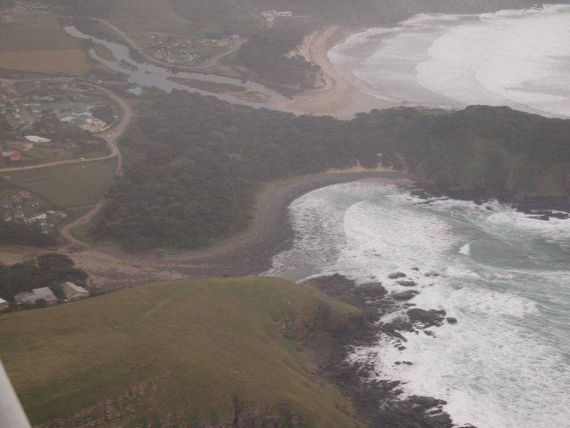
Beautiful Bays and Coves are everywhere.
Like sirens luring hapless sailors towards the rocks, so too had the promise of these waves drawn me to my current predicament. I was about to land on a deserted beach on a part of the ancient African coast in a light aircraft with the sole intention of going surfing.
This was not a crash landing or a mechanical failure. We had chosen our day. We had plotted our course and we had flown out into the wilderness wondering if it was actually possible to do what we wanted to do. We had engineered this with intent. At every opportunity I could have avoided it but now the moment of truth was approaching.
Having chased the cows off the runway, we flew wide out over the point and circled back towards the beach to make our approach for the landing. The cockpit was cramped and once again I fought off that lingering feeling of claustrophobia as the pins and needles tingled in my legs and arms and my jacket and camera and two surfboards and pilot had the Super Cub cockpit filled to overflowing. Somehow I managed to extract my phone from my pocket while fighting off what felt like an impending panic attack.
Tom had gone curiously silent, his full attention now on piloting the small craft into the approach.
“One hour before low tide and one hour after low tide, that is our window before the runway gets flooded.”
Tom’s words echoed through my mind as I watched white tongues of surf licking the beach clean in front of us. The cows that had previously crowded our runway stood to one side with bovine indifference. After all what was one more buzzing insect in the sky to them on a deserted Transkei beach.
I readied my cell phone camera. A wry thought crossed my mind even as the tentacles of fear wrapped themselves around my heart. Was I about to become a narcissistic spectator in my own disaster? A mess of mangled bodies, broken struts and bent steel or a gentle touchdown? Either way I knew it would look good on film. The thing was, I’d just realized with absolute certainty I really didn’t want to die today.
.jpg)
Selfie on the beach with Tom changing in the background.
Our flyby to chase the cows off the beach and clear the runway had shown me how big the surf was. If we survived the landing then the next obstacle we faced was the surf itself, well that was if we survived the sharks. This Point is the most perfect wave in the whole of the Transkei, but it is also without doubt the spookiest. For how few people have surfed there and how many fatal attacks there have been there the odds actually defy rational contemplation. If we survived the sharks, we’d have to deal with the surf and it was much bigger - much, much bigger - than we thought it would be.
We’d waited for the perfect day to do this but unbelievably it was, dare we say it, too perfect? We’d wanted a solid swell to do this and by god we’d gotten one.
Tom’s initial idea had been to attach the boards to the outside of the aircraft with a curious sucker device. From the start I’d been skeptical of this plan, but I couldn’t argue.
“Fishing rods will stay fixed to the roof of a car at 120kmph with those things!” He said.
“We’ll easily be able to stick a couple of boards onto the fuselage of the plane with some of those bad boys…” He enthused.
Despite the fact that a Super Cub presents a modest amount of cockpit space, in aviation terms if you are planning on landing a plane on the beach according to Tom it was the ideal tool for the job.
The idea was that we’d be able to attach a suitable quiver of assorted wave riding vehicles to the exterior of our aircraft. We’d fly below the radar of anyone who might be interested in thwarting our unauthorized and unlawful endeavor and head south to find wave riding nirvana on the lost coast of the Transkei.
Tom had organized the aircraft.
“It’s the ultimate bush plane, it will work perfectly on the beach!”
The least I could do was source the correct sucker devices. While I trawled the fishing shops of downtown Durban for suitable said sucker devices my doubt on this theory only grew. Thankfully when I had arrived at Virginia airport armed with sucker devices up the yin yang I also came armed with my plan B, along with a carload of surfboard options.
In a discreet area of the airport, tucked away behind a hanger and prying eyes, Tom and I tried desperately to make the surfboards stick to the exterior of the plane with the sucker devices. The pressure was on. If we didn’t get there for the tidal window around low tide, the surf would flood the ‘runway.’
Finally Tom threw his hands up in defeat. I could see the frustration and disappointment on his face. This was his baby, an idea that he had hatched several years ago while hiking along a deserted Transkei beach. Tom was not a cowboy weekend pilot. Flying was what he did for a living and like me he was a lifelong and passionate surfer. Walking slowly along that beach his pilot’s eye told him that the long, straight stretch of uninterrupted and compacted sand would make the perfect runway at low tide. The fact that this runway was situated right next to the most perfect wave in the Transkei was a co-incidence that he could not ignore. When he’d presented his idea to me over a year before I’d jumped at the idea mainly because of the novelty but also because accessing this Point conventionally was a two-day drive along some of the worst roads in South Africa. The idea of flying in and out on a surgical strike with the prospect of scoring some epic surf was hugely appealing. Also the opportunity of surveying the coast from the air was too good for me to miss.
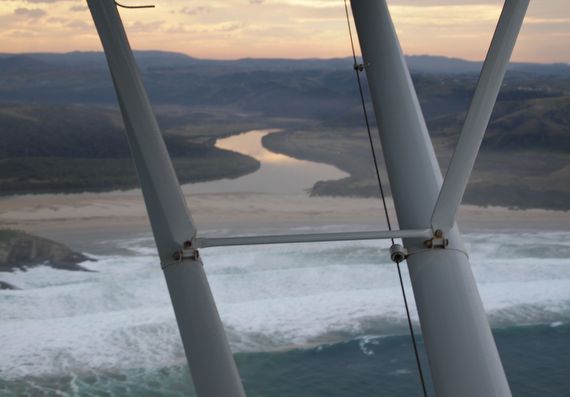
The Wild Coast - so pretty.
For over 20 years I’d explored the Transkei. Slowly and painstakingly and with many, many wrong turns I’d discovered some of her secrets. The beauty of the Transkei lies in its wildness and inaccessibility. Mostly it is referred to as ‘The Wild Coast’ for good reason. Covering short distances can take days because of the rough terrain. If it rains the roads can get so bad that you get stuck in bogged down mud ruts even in a 4X4. The rivers can flood the crossings leaving you trapped until the water subsides. The flipside to the wildness is natural beauty in abundance. On land there are bush-covered hillsides, stunning river valleys and estuaries, pristine beaches, coves and bays, headlands, dramatic cliffs and waterfalls plunging directly into the sea. In the water the surf potential of this area is staggering. In fact often they get too much swell! It is precisely at this point on the East African Coast where the continental shelf is at its narrowest. The strong and warm Mozambican current runs close to the shore and the powerful long period winter swells, born in the Roaring Forties, march up against that current. These opposing forces are ingredients to a freak wave phenomenon, one that strikes fear into the heart of even the biggest of ships captains. Below the surface the ocean is teaming with sea life of every kind. Whales, dolphins, turtles, fish, and of course, the sharks… Aside from the remote location, difficult access and fickle conditions, it is the deadly reputation for fatal Shark attacks that keeps surfers away in droves. Statistically, Second Beach at Port St Johns holds the dubious distinction of being the most dangerous beach to go swimming anywhere in the world. They have had six fatal attacks in as many years. If you consider how few people actually enter the water along The Wild Coast every year, this is a terrifying record.
Amazingly our landing was as smooth as any I’ve ever had on tarmac. One moment we were in that curious state of suspension that is flight, the next we were skimming along the beach, waves not six feet from the wheels. As Tom taxied to the far end of the beach I looked at the surf in earnest. It was huge, six to ten feet easily. There was not a soul in sight, not that we’d expected to see one.
When we’d planned this mission we knew we wouldn’t pull the trigger unless there was a decent swell running, so we’d been thinking about bringing step up boards in the 6’5”- 6’8” range. That had all gone out of the window when I’d put plan B into effect. With Tom’s sucker theory debunked I presented my alternative. Initially we’d discounted the idea of getting boards into the cockpit because the inside of a Super Cub is not long enough to fit even a board as short as 5’10” and it is not wide enough to accommodate the depth of surfboard fins. These days with removable fins the width was not as much an issue as the length. For several months before, I’d been working closely with Spider Murphy on a hybrid surfboard design called the Hydro-X. The basic principle was to make a shorter surfboard with a longer rail line and a wider nose, but with the same volume as a regular board. They were designed to be ridden around six inches shorter than your normal board. These boards were easy to ride well and performed amazingly in the tube. Spider and I had been experimenting with a 5’6” and a 5’ 8”, both of which went really well in waves up to around six feet. Beggars can’t be choosers and when I suggested we try to take the Hydro’s and put them in the plane rather than attached to the exterior we realized we could just squeeze them into the cockpit, but once in we could barely move the fit was so tight.
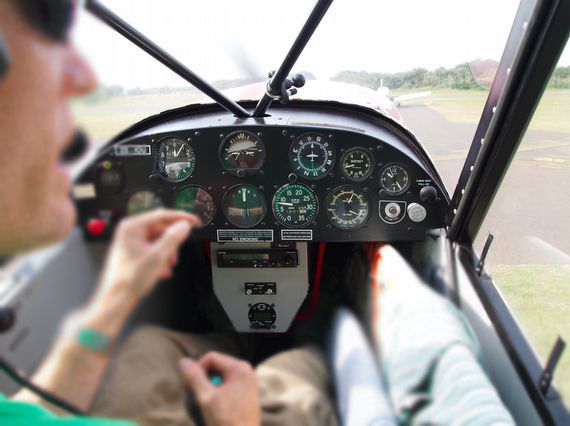
Boards squeezed into the cockpit of the Super Cub.
Now landing on the beach and looking at the waves we were going to try and ride I felt well and truly under-gunned. For conditions like this I would normally go to a solid 7’0”, but at least we had boards. Besides, the adrenaline from the landing was still coursing through our veins.
We had timed our landing perfectly with the tide and even the refuel we’d been forced to make at Margate on the way down (so we’d have enough fuel to make it back to Durban in one jump before nightfall) hadn’t slowed us down too much. That said we quickly realized that the 2 hr window we’d initially budgeted on had been reduced to an hour and a half max, due to the size of the surf and the consequent surge rushing up the beach. We fixed fins and donned wetsuits in a frenzy of adrenaline-fuelled activity while constantly looking up to gauge the rhythm of the ocean. I offered Tom the 5’8” and I took the 5’6”. I’d never surfed anywhere in The Transkei at this size before, let alone on boards this small. As we ran up the point to the jump off spot we passed Alex Macun's memorial plaque. Erected by his family after he suffered a fatal attack by a Great White Shark in 1989 while surfing here, it was a sobering reminder of who the real locals at this spot are.
The normal jump off spot was overwhelmed by volleys of white water tearing up the muscle-clad rocks and cascading into the little gullies and fissures that lend the point its unique character. Instead we headed a little further up the point to more of a ledge. Normally this would have been a no-go zone but because of the size of the surge if you timed it right you could enter the water there. Then you’d have to paddle for your life to avoid being washed backwards over the razor sharp rocks. Literally as I got to the ledge I saw a little gap. Maybe it was all the adrenaline in my system or perhaps just the knowledge that we were racing the clock, but I didn’t hesitate. I jumped in and paddled that little 5’6” as if my life depended on it. Tom was right behind me and he too launched straight in.
I was amazed at the power in the ocean. On a bigger board you can float over the foam and cut through the chop as you paddle. On a small board every push under is critical, every whirlpool or eddy an obstacle that needs to be overcome. Thankfully I was very surfing fit. Tom had been doing more flying than surfing recently with his commercial aviation job cutting into his water time. I could tell out of the corner of my eye that I was steadily pulling away from him. I didn’t paddle straight out; face on, into the swell, but rather at 45 degrees to the rocks as sometimes the wash down the point can actually help you get out. In any paddle out of consequence you run through a seesaw of emotions. Determined, hopeful, fearful, discouraged, hopeful once again, elated. Terrified. With my lungs on fire and my arms dead at my sides I had to dig deep and deeper still. After at least 20 push unders I thought I was out, but when I looked up I saw that there was a mammoth wave bearing down on us. It was at least 50 percent bigger than anything else I’d seen that day, a full on Wild Coast rouge wave come to exact its toll.
I stopped paddling.

One of many points cooking on the day.
It was clear that we’d both be caught inside by this wave. I knew that if I bailed the chances of the board and leash surviving were remote. I was already far out to sea by normal standards and I didn’t relish the prospect of a long swim back to the beach through this thundering surf without a board. Equally attempting to push under this wave seemed like a ludicrous proposition. I have surfed Waimea, Avalanche, Himalayas, Mavericks, Dungeons and Sunset (SA). I’ve seen and surfed and been beaten by my share of decent sized waves. In recent years I’ve found yoga and breathold training have made a huge difference. In only 10 seconds you can prepare your body for a remarkable beating if you breathe correctly. I watched with sick fascination as the lip of the wave detonated 20 feet in front of me. The only benefit to surfing a 5’6” I thought would be how easy it would be to push under, but there was something else I hadn’t counted on. The reduced surface area of the small board in the turbulence of a wave that large actually made it easier to control than a bigger board. I pushed under as deep as I could before wrapping my legs and arms around the board and hugging my cheek to the deck. I braced myself for impact as the wall of water rolled over me expecting to be mauled. Instead after a brief and fierce downward impact I was shot out of the back like a cork unscathed. I looked back over the whitewash that stretched towards the beach. Tom was nowhere in sight.
Catching waves that size on a 5’6” was going to be a new experience. I was determined to at least catch one. I’d barely recovered my breath when a set of waves started peeling down the point. Substantially smaller than the wave that had just caught me, they were still a good 10ft. Initially I thought I’d paddle over the first set to get a feel for it, but as the first wave approached I realized I was in the perfect place to have a go. I swung around and paddled. To add to my lucky positioning there was a bit of chop at the top of the wave that gave me a little chip shot into the wave and a convenient and game-saving early entry to the long wall of water.
Riding such a big wave on a small board was actually a really cool feeling. I crouched low in a functional utility squat (read: not pretty on the eye) and drew out my turns. I was amazed at the speed and control of the little Hydro. I kicked out before the wave closed out at the end and paddled back up the point very slowly enjoying my newfound sense of confidence. My second wave was a lot more critical as I didn’t have the benefit of the chip shot to get me in early. I nearly blew it coming off the bottom, stalled and just managed to kick out over the top before the wave ran away from me. My third wave I got comprehensively thrashed after getting pitched on the takeoff. The little board just didn’t have the momentum or speed to break free of the lip and I went down the mineshaft feet first. How the leash held and the board didn’t break I don’t know. Gasping I paddled out for my final attempt.
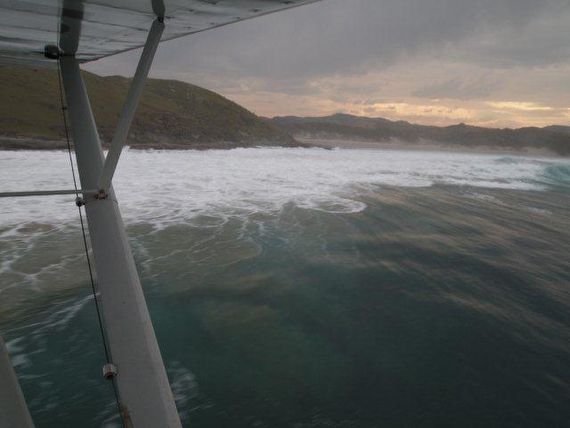
Surfing like a seagull on the way home.
The day had been characterised by an ethereal light caused by lots of low soft cloud. It seemed the further south we headed the lighter the wind and the more luminous the light. I sat out there drinking it all in wondering at the day I was having. I thought about the sharks that were almost certainly below me but strangely I was more concerned about catching another wave and somehow getting the plane safely back off the beach and back in to the air than I was about the sharks. If anything the surf was cleaning up and getting better all the time. I was absolutely stoked. I knew I didn’t have the luxury of time to choose a perfect last wave so I decided to just try the first one that came my way. As it turned out it was a bomb. I got in really late as I was expecting to do, but instead of trying to make the drop I angled down the face and pulled straight into the tube. Wow! What a sight. The whole bay was framed in a liquid archway, moving but stationary in my mind forever. I felt the tube breathe in before it spat me out in a rainbow of spray onto a long glassy wall. This time I rode all the way through to the beachbreak and straitened out as the wave closed out behind me. I got smashed again and this time I hit the bottom headfirst. Thankfully the most I got was a small graze on my bald head, a mere scratch in retrospect. I washed up on the beach to find Tom waiting for me. He was gutted he hadn’t gotten out. That rogue wave had mowed him down completely and washed him right down the point.
As we repacked the plane I could see that several parts of our runway had already been subjected to flooding by the combination of the big sets and the now incoming tide. We were cutting our exit fine and we knew it. Tom lined the aircraft up, gunned the engine and waited. Precious time ticked by while we waited for a gap, then suddenly Tom released the breaks and opened up the throttle and we were off bouncing down the beach with the water lapping at our wheels. I thought the landing was wild, but the takeoff was just incredible. In a few hundred meters we broke free of the beach and soared above the beautiful bay. As I looked back down onto the point I could hardly believe that only moments before I’d been standing in a massive barrel in amongst all that energy. My wet beard reminded me of just how recently that was.
A sense of contentment and companionable silence filled the cockpit on the way back to Durban. We scouted all the secret bays, reefs and headlands and marveled at some new discoveries. These would no doubt require a closer and more thorough investigation in the future. On one long point Tom dropped down to almost sea level and timed it perfectly to surf along the displaced air of the swell line as it raced down the point, the way a sea gull does. All the time we marveled at the absolute sublime beauty of The Wild Coast. The dramatic visuals provided an incredible dessert to the experiential feast we’d just shared.
As we rounded the Bluff to make our approach into Durban the sun was nearing the horizon and the City lay bathed in a glow of golden light. The swell lines continued to pour into the bay. As we touched down I had the feeling I’d experienced a miracle of sorts, perhaps several in fact, on this truly special day.
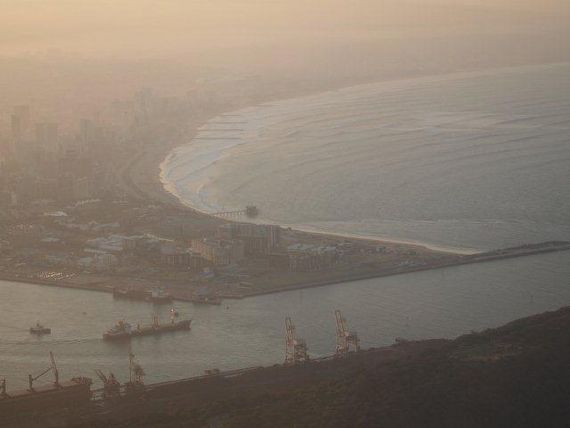
Swell lines wrapping into the Durban Bay. Notice the waves breaking on the mound.
|

